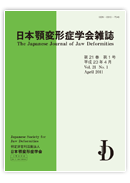All issues

Volume 21 (2011)
- Issue 4 Pages 215-
- Issue 3 Pages 171-
- Issue 2 Pages 31-
- Issue 1 Pages 1-
Predecessor
Volume 21, Issue 1
Displaying 1-3 of 3 articles from this issue
- |<
- <
- 1
- >
- >|
Original Articles
-
RYOKO YOSHIMOTO, TOMOKO TAKAHASHI, JUN ANDOH, SYOUJI FUJITA, AYA KAWAM ...2011 Volume 21 Issue 1 Pages 1-9
Published: April 15, 2011
Released on J-STAGE: February 28, 2012
JOURNAL FREE ACCESSObjective–The purpose of this study was to investigate the histopathological changes of the matrix components of cartilage in the articular condyle after removal of the side shift plate. The expressions of type X collagen and vascular endothelial growth factor (VEGF) were studied histopathological and immunohistochemically.
Design–Side shift plates were attached to the anterior teeth in the maxilla of 6-week-old male rats for mandibular displacement. The plates were worn for 8 weeks. Observations were made at 0, 1, 2, 4 and 8 weeks after removal of the side shift plate.
Results–In histopathological findings, the timing of proliferation of the layer of hypertrophy varied between the bilateral sides. In immunohistochemical findings, a significant elevation in the expression of type X collagen in the displacement side was observed at 1 week after removal of the side shift plate.
Moreover, the expressions of VEGF were elevated in both sides (displacement and non-displacement side) at 0-1 weeks after removal of the side shift plate. At 4 weeks after removal of the side shift plate, the significant elevation in expressions of type X collagen and VEGF was reduced in the displacement side.
Conclusions–It is suggested that the cartilage of the condyle is restored by the increase in type X collagen and VEGF by early removal of the causes during growth.View full abstractDownload PDF (1483K) -
ATSUSHI DANJO, NOBUHIRO NOGUCHI, YOSHIO YAMASHITA, MASAHITO SHIGEMATSU ...2011 Volume 21 Issue 1 Pages 10-17
Published: April 15, 2011
Released on J-STAGE: February 28, 2012
JOURNAL FREE ACCESSSagittal splitting ramus osteotomy (SSRO) is commonly used to treat jaw deformities. We must avoid the occurrence of problems that may disrupt the social relationships of our patients.
We investigated cases involving unfavorable bone splitting or fixation and studied their causes and measures to prevent these problems.
In the last 13 years, 261 SSROs have been performed in our department, of which 11 were problematic cases associated with bone splitting or fixation. The problems consisted of six unfavorable fractures during surgery, one unfavorable fracture postoperatively, and one case each of a screw loosening postoperatively, a miniplate breaking postoperatively, a miniplate loosening postoperatively, and lateral dislocation of the condyle.
The most frequent problem was an unfavorable fracture during surgery. The six cases included five bad splits and one incorrect horizontal cut in the lingual aspect of the mandibular ramus. The unfavorable postoperative fracture also resulted from an incorrect cut in the lingual aspect of the mandibular ramus. We treated these cases with re-fixation of the mandible, additional intermaxillary fixation, or both. In all cases, we confirmed bone healing within 1 year. In the case of lateral dislocation, although the patient has had symptoms for a long time, no functional problems have occurred.
The loosening or breaking of the miniplate or screw was caused by an incorrect drilling angle into cortical bone or inadequate mobility of the proximal segments due to insufficient dissection of masticatory muscles. The surgeons' skill also affected the results. In each case, the problem might have been avoided if the ramus shape had been known preoperatively and the operation simulated. The basic technique of SSRO has not changed, but the methods and materials used for bone fixation are improving. To avoid these problems, it is essential to understand the patient's anatomy, to simulate surgery and to become proficient with the surgical techniques.View full abstractDownload PDF (759K)
Case Report
-
—Changes in Skeletal, Occlusal and Nasal Morphology—TAKANORI ARASHIYAMA, TAKAFUMI MIYAGI, JUN-ICHI FUKUDA, ISAO SAITO, RIT ...2011 Volume 21 Issue 1 Pages 18-29
Published: April 15, 2011
Released on J-STAGE: February 28, 2012
JOURNAL FREE ACCESSAcromegaly is an endocrine disease caused by enhanced growth hormone (GH) production/secretion from the pituitary gland. The most frequently observed underlying disease is GH-producing adenomas in the anterior pituitary. We report the treatment course and change of nasal morphology with time in a patient with mandibular prognathism associated with acromegaly.
A 21-year-old female visited our department with the chief complaint of mandibular protrusion. She showed hypertrophy of the four limbs, thickness of the facial skin, hypertrophy of the nasal alae and lips, protrusion of the upper orbital margin, and cross bite. The GH and somatomedin levels were high. Magnetic resonance imaging (MRI) revealed a tumor in the anterior pituitary. A diagnosis of skeletal mandibular prognathism associated with acromegaly due to a pituitary tumor was made, and the pituitary tumor was resected at the Department of Neurological Surgery of our hospital. Subsequently, since the GH and somatomedin levels decreased almost to the normal ranges, preoperative orthodontic treatment was initiated, and bilateral sagittal splitting ramus osteotomy was performed 18 months after the tumor resection. Stable occlusion was maintained without changes in general condition 24 months after the orthognathic surgery at the age of 26 years 1 month. The nasal morphology markedly changed with time after resection of the pituitary tumor.View full abstractDownload PDF (920K)
- |<
- <
- 1
- >
- >|